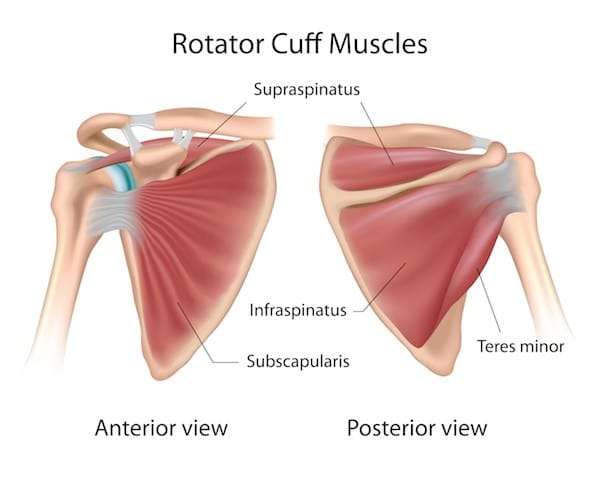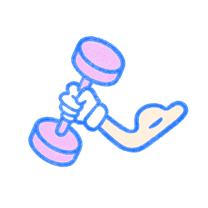Be sure you understand these topics before taking the official exam. It’s easy to tell yourself that you understand something complex like rotator cuff muscle anatomy (number 12), but how well do you really know these topics? A great way to test yourself is to explain the concept to a friend or family member. If you can teach them about the topic, you know you’ve fully grasped the concept. (Hint: This is actually a study technique called the Feynman Technique.)
Take note of these 15 items and make sure you’ve fully mastered them before you sit for the official ACSM CPT exam.
1. Domain Breakdown
If you’re cramming for the exam, don’t overload yourself with Domain IV. Based on the CPT Domains (outlined below), you should first study Domains II and III, followed by Domain I, and finishing with Domain IV. With that being said, do not skip any of the Domains as you will see all of these on the official ACSM CPT exam.
| ACSM Certified Personal Trainer Job Task Analysis | % |
| Domain I: Initial Client Consultation & Assessment | 25% |
| Domain II: Exercise Programming & Implementation | 45% |
| Domain III: Exercise Leadership & Client Education | 20% |
| Domain IV: Legal & Professional Responsibilities | 10% |
2. Spotting Techniques
Know where to stand, where your hands should be, etc. These questions are very detailed on the exam.
3. Risk Stratification
You will be asked how many risk factors a specific patient might face and what sort of stratification to put people in.
4. Concentric & Eccentric
How do they apply to agonist and antagonist muscles in specific movements? How do they apply to running or walking downhill or uphill? Make sure you understand these differences.
5. Muscle Locations
Know your basic muscle anatomy so you’ll have an understanding of how various exercises work specific muscles and which muscles to target based on a client’s needs.
6. Heart Rate Calculations
Be sure that you know how to calculate maximum heart rate, heart rate reserve (Karvonen formula), and a specific heart rate at a given percentage.
7. BMI
Know how to calculate BMI and ideal body weight. This includes how to convert from pounds to kilograms and inches to meters.
8. Special Considerations
Understand the special considerations in exercise for children, the elderly, and pregnant women. You should also know what positions pregnant women should never exercise in and why.
9. Planes of Motion
Understand the planes of motion that muscles move in and the types of joint movements.
10. Contraindications
Know the definitions of absolute and relative contraindication.
- Absolute contraindication: Should not perform until conditions are stabilized or adequately treated
- Relative contraindication: May be tested only after careful evaluation of risk to benefit ratio
11. Calories
Know how many calories are in macronutrients and how many calories are in a pound.
- Macronutrients: Carbohydrates, protein, fat
- 3,500 calories = 1 pound
12. Rotator Cuff Muscles
You can remember the rotator cuff muscles with ‘SITS’ muscles: Supraspinatus, Infrapspinatus, Teres Minor, Subscapularis

- Supraspinatus: Originates above the spine of the scapula and inserts on the greater tuberosity of the humerus. It abducts, or elevates, the shoulder joint.
- Infrapspinatus: Originates below the spine of the scapula, in the infraspinatus fossa, and inserts on the posterior aspect of the greater tuberosity of the humerus. It externally rotates the shoulder joint.
- Teres Minor: Originates on the lateral scapula border and inserts on the inferior aspect of the greater tuberosity of the humerus. It externally rotates the shoulder joint.
- Subscapularis: Originates on the anterior surface of the scapula, sitting directly over the ribs, and inserts on the lesser tuberosity of the humerus. It works to depress the head of the humerus allowing it to move freely in the glenohumeral (shoulder) joint during elevation of the arm.
All four rotator cuff muscles work together to stabilize the head of the humerus in the glenohumeral (shoulder) joint.
13. Resistance Training
Understand the different types of resistance training. This includes supersets, splits, pyramids, etc.
14. General Exercise Prescription
Know the general exercise prescription for the healthy population.
15. Condition Recommendations
Know what recommendations are appropriate for hot and/or humid conditions.
What’s Next?
It’s a lot, but with careful prep and a good study strategy, you’ll be on your way to passing your ACSM CPT exam. If you’re looking for a little extra study help, Pocket Prep has you covered with study support through the convenience of a mobile app.
The Fitness Pocket Prep App has exam prep for the ACSM CPT exam, as well as many other exams like NASM CPT and NSCA CSCS. It’s free to download and all premium accounts feature a three-day free trial period. When you’re ready to study, we’re here to help.

